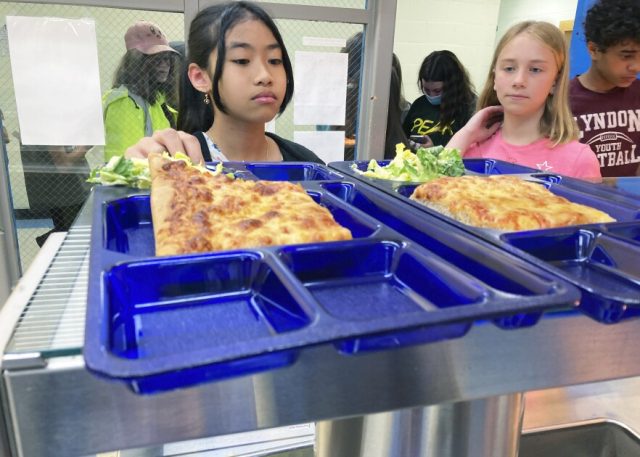[ad_1]
Rachel Palmer has been the nurse at Michigan’s Dundee Community Schools, a district of about 1,500 students, for seven years. In that time, especially since the the onset of the pandemic, she’s seen an uptick in students who don’t have enough to eat.
This year, she reports that close to 35 percent of the district’s students qualify for free and reduced-price meals , an estimated 5 percent increase over last year.
Palmer is getting better at recognizing hunger among students. “I think I’m more attuned to the symptoms now,” she said. “When a student comes into the nurse’s office, I have to pick up: Is it a stomachache from anxiety, sickness, or not enough food?”
Palmer is not the only person in the school system aware that some students don’t have enough to eat. Randall Rice Jr., a 4th grader at Dundee Elementary School, noticed it, too, and three years ago, he decided to do something about it.
He approached his parents and told them that he didn’t want any of his classmates to be suffering, that he “wanted them to have full stomachs and feel well.” That led to the idea of collecting food for families who might be in need of extra support around the holidays.

The Randall family now is in its third year of collecting monetary donations during the holiday season from community members to buy food for the school district’s food pantry, which Palmer launched in 2019 when she became aware of the increasing prevalence of food insecurity among district families.
Palmer uses the food in the pantry for the district’s “backpack program,” which involves filling up backpacks of food that go home with students on weekends. The additional support from the Rice family goes toward filling backpacks with extra food before students leave for the extended winter break in December.
Barriers to accessing assistance
Food insecurity—a lack of consistent access to nutritious food—is prevalent among America’s children. In 2021, 12.5 percent of the nation’s households with children experienced food insecurity, according to the U.S. Department of Agriculture. Various efforts help combat the problem, from grassroots programs like the Dundee Community Schools food pantry to long-established initiatives such as the USDA’s Supplemental Nutrition Assistance Program, whose first iteration launched in 1939. But barriers sometimes prevent school-children from taking advantage of them.
Stigma surrounding food insecurity is one.
Consider the Dundee Community Schools backpack program. Palmer explains that the district makes it as confidential and easy as possible for families to register for the program; for instance, there are no financial barriers to entry (such as proof of annual income), and very few people in the school community know who participates. But families must self-identify to enroll in the program. Only 29 families from the elementary school, some that also have children in the district’s middle and high schools, have done so this year. This, despite an estimated 35 percent of Dundee students who qualify for free and reduced-price meals.
In a 2020 study by the Society for Nutrition Education and Behavior that explored issues related to food insecurity and childhood hunger among families living in rural Appalachia, researchers found that stigma related to self-reliance expectations was a significant barrier to families reporting food insecurity, childhood hunger, and participation of children in food-assistance programs.
Parents aren’t the only ones who feel the stigma around asking for help.
“When students get into middle school, they don’t want to take the backpacks home,” said Palmer. Among families with multiple children enrolled in the backpack program, she said the school tends to give the backpacks to the youngest to take home, as they are less likely to be self-conscious about accepting them.
Access to assistance during school breaks
Even when students and families willingly accept food assistance, it can be harder to come by during extended school closures such as winter break.
When schools close, children often can’t access free and reduced-price school-based meals. The USDA does provide funding to eligible schools and other providers to serve meals during summer and other school breaks, but those tend to require that families live in high-poverty communities or that they fill out applicatons in order for children to receive free meals.

Then there are smaller, less complicated responses to winter break hunger, such as Randall’s: “We go to the store, buy a bunch of simple stuff, fill our car, and bring it to school.”
When asked how his act of kindness makes him feel, Randall offers this one-word response: “Happy.”
So, too, is Palmer, who shares her excitement over seeing the Rice family car “filled to the brim” with food that provides additional assurance that Dundee families won’t be hungry during the winter holiday break.
“He’s not in it for the glory,” Palmer said.
But Randall’s good deed has not gone unnoticed in the tight-knit community of Dundee. When a local TV station ran a segment on it, Palmer said donations came pouring in. Also, after learning about his charitable act, the president of the Village of Dundee asked Randall to participate in this year’s annual Dundee tree-lighting ceremony.
The 10-year-old appears to be taking it all in stride. When asked what he would like to receive this holiday season, Randall seemed caught off guard—as if he hadn’t really given the question much thought. “Some books, maybe some Legos,” he said softly.
[ad_2]
Source link











